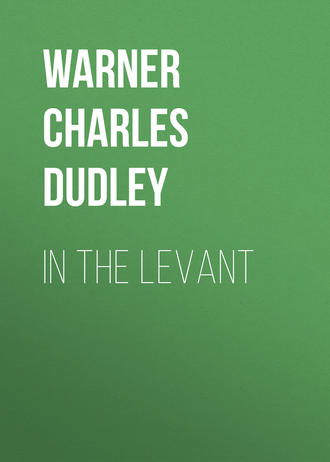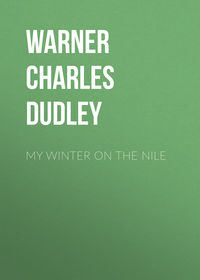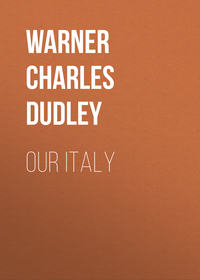 полная версия
полная версияIn The Levant
It seems also to have been connected with the palace on Zion which David built, for it is the tradition that it was from this tower that the king first saw Bathsheba, the wife of Uriah, when “it came to pass in an eventide that David arose from off his bed, and walked upon the roof of the king’s house: and from the roof he saw a woman washing herself; and the woman was very beautiful to look upon.” On the other side of the city gate we now look down upon the Pool of Bathsheba, in which there is no water, and we are informed that it was by that pool that the lovely woman, who was destined to be the mother of Solomon, sat when the king took his evening walk. Others say that she sat by the Pool of Gibon. It does not matter. The subject was a very fruitful one for the artists of the Renaissance, who delighted in a glowing reproduction of the biblical stories, and found in such incidents as this and the confusion of Susanna themes in which the morality of the age could express itself without any conflict with the religion of the age. It is a comment not so much upon the character of David as upon the morality of the time in which he lived, that although he repented, and no doubt sincerely, of his sin when reproved for it, his repentance did not take the direction of self-denial; he did not send away Bathsheba.
This square old tower is interiorly so much in ruins that it is not easy to climb to its parapet, and yet it still has a guardhouse attached to it, and is kept like a fortification; a few rusty old cannon, under the charge of the soldiers, would injure only those who attempted to fire them; the entire premises have a tumble-down, Turkish aspect. The view from the top is the best in the city of the city itself; we saw also from it the hills of Moab and a bit of the Dead Sea.
Close by is the Armenian quarter, covering a large part of what was once the hill of Zion. I wish it were the Christian quarter, for it is the only part of the town that makes any pretension to cleanliness, and it has more than any other the aspect of an abode of peace and charity. This is owing to its being under the government of one corporation, for the Armenian convent covers nearly the entire space of this extensive quarter. The convent is a singular, irregular mass of houses, courts, and streets, the latter apparently running over and under and through the houses; you come unexpectedly upon stairways, you traverse roofs, you enter rooms and houses on the roofs of other houses, and it is difficult to say at any time whether you are on the earth or in the air. The convent, at this season, is filled with pilgrims, over three thousand of whom, I was told, were lodged here. We came upon families of them in the little rooms in the courts and corridors, or upon the roofs, pursuing their domestic avocations as if they were at home, cooking, mending, sleeping, a boorish but simple-minded lot of peasants.
The church is a large and very interesting specimen of religious architecture and splendid, barbaric decoration. In the vestibule hang the “bells.” These are long planks of a sonorous wood, which give forth a ringing sound when struck with a club. As they are of different sizes, you get some variation of tone, and they can be heard far enough to call the inmates of the convent to worship. The interior walls are lined with ancient blue tiles to a considerable height, and above them are rude and inartistic sacred pictures. There is in the church much curious inlaid work of mother-of-pearl and olive-wood, especially about the doors of the chapels, and one side shines with the pearl as if it were encrusted with silver. Ostrich eggs are strung about in profusion, with hooks attached for hanging lamps.
The first day of our visit to this church, in one of the doorways of what seemed to be a side chapel, and which was thickly encrusted with mother-of-pearl, stood the venerable bishop, in a light rose-colored robe and a pointed hood, with a cross in his hand, preaching to the pilgrims, who knelt on the pavement before him, talking in a familiar manner, and, our guide said, with great plainness of speech. The Armenian clergy are celebrated for the splendor of their vestments, and I could not but think that this rose-colored bishop, in his shining framework, must seem like a being of another sphere to the boors before him. He almost imposed upon us.
These pilgrims appeared to be of the poorest agricultural class of laborers, and their costume is uncouth beyond description. In a side chapel, where we saw tiles on the walls that excited our envy,—the quaintest figures and illustrations of sacred subjects,—the clerks were taking the names of pilgrims just arrived, who kneeled before them and paid a Napoleon each for their lodging in the convent, as long as they should choose to stay. In this chapel were the shoes of the pilgrims who had gone into the church, a motley collection of foot-gear, covering half the floor: leather and straw, square shoes as broad as long, round shoes, pointed shoes, old shoes, patched shoes, shoes with the toes gone, a pathetic gathering that told of poverty and weary travel—and big feet. These shoes were things to muse on, for each pair, made maybe in a different century, seemed to have a character of its own, as it stood there awaiting the owner. People often, make reflections upon a pair of shoes; literature is full of them. Poets have celebrated many a pretty shoe,—a queen’s slipper, it may be, or the hobnail brogan of a peasant, or, oftener, the tiny shoes of a child; but it is seldom that one has an opportunity for such comprehensive moralizing as was here given. If we ever regretted the lack of a poet in our party, it was now.
We walked along the Armenian walls, past the lepers’ quarter, and outside the walls, through the Gate of Zion, or the Gate of the Prophet David as it is also called, and came upon a continuation of the plateau of the hill of Zion, which is now covered with cemeteries, and is the site of the house of Caiaphas and of the tomb of David and those Kings of Jerusalem who were considered by the people worthy of sepulture here; for the Jews seem to have brought from Egypt the notion of refusing royal burial to their bad kings, and they had very few respectable ones.
The house of Caiaphas the high-priest had suffered a recent tumble-down, and was in such a state of ruin that we could with difficulty enter it or recognize any likeness of a house. On the premises is an Armenian chapel; in it we were shown the prison in which Christ was confined, also the stone door of the sepulchre, which the Latins say the Armenians stole. But the most remarkable object here is the little marble column (having carved on it a figure of Christ bound to a pillar) upon which the cock stood and crowed when Peter denied his Lord. There are some difficulties in the way of believing this now, but they will lessen as the column gets age.
Outside this gate lie the desolate fields strewn with the brown tombstones of the Greeks and Armenians, a melancholy spectacle. Each sect has its own cemetery, and the dead sleep peaceably enough, but the living who bury them frequently quarrel. I saw one day a funeral procession halted outside the walls; for some reason the Greek priest had refused the dead burial in the grave dug for him in the cemetery; the bier was dumped on the slope beside the road, and half overturned; the friends were sitting on the ground, wrangling. The man had been dead three days, and the coffin had been by the roadside in this place since the day before. This was in the morning; towards night I saw the same crowd there, but a Turkish official appeared and ordered the Greeks to bury their dead somewhere, and that without delay; to bury it for the sake of the public health, and quarrel about the grave afterwards if they must. A crowd collected, joining with fiery gesticulation and clamor in the dispute, the shrill voices of women being heard above all; but at last, four men roughly shouldered the box, handling it as if it contained merchandise, and trotted off with it.
As we walked over this pathless, barren necropolis, strewn, as it were, hap-hazard with shapeless, broken, and leaning headstones, it was impossible to connect with it any sentiment of affection or piety. It spoke, like everything else about here, of mortality, and seemed only a part of that historical Jerusalem which is dead and buried, in which no living person can have anything more than an archaeological interest. It was, then, with something like a shock that we heard Demetrius, our guide, say, pointing to a rude stone,—
“That is the grave of my mother!”
Demetrius was a handsome Greek boy, of a beautiful type which has almost disappeared from Greece itself, and as clever a lad as ever spoke all languages and accepted all religions, without yielding too much to any one. He had been well educated in the English school, and his education had failed to put any faith in place of the superstition it had destroyed. The boy seemed to be numerously if not well connected in the city; he was always exchanging a glance and a smile with some pretty, dark-eyed Greek girl whom we met in the way, and when I said, “Demetrius, who was that?” he always answered, “That is my cousin.”
The boy was so intelligent, so vivacious, and full of the spirit of adventure,—begging me a dozen times a day to take him with me anywhere in the world,—and so modern, that he had not till this moment seemed to belong to Jerusalem, nor to have any part in its decay. This chance discovery of his intimate relation to this necropolis gave, if I may say so, a living interest to it, and to all the old burying-grounds about the city, some of which link the present with the remote past by an uninterrupted succession of interments for nearly three thousand years.
Just beyond this expanse, or rather in part of it, is a small plot of ground surrounded by high whitewashed walls, the entrance to which is secured by a heavy door. This is the American cemetery; and the stout door and thick wall are, I suppose, necessary to secure its graves from Moslem insult. It seems not to be visited often, for it was with difficulty that we could turn the huge key in the rusty lock. There are some half-dozen graves within; the graves are grass-grown and flower-sprinkled, and the whole area is a tangle of unrestrained weeds and grass. The high wall cuts off all view, but we did not for the time miss it, rather liking for the moment to be secured from the sight of the awful desolation, and to muse upon the strange fortune that had drawn to be buried here upon Mount Zion, as a holy resting-place for them, people alien in race, language, and customs to the house of David, and removed from it by such spaces of time and distance; people to whom the worship performed by David, if he could renew it in person on Zion, would be as distasteful as is that of the Jews in yonder synagogue.
Only a short distance from this we came to the mosque which contains the tomb of David and probably of Solomon and other Kings of Judah. No historical monument in or about Jerusalem is better authenticated than this. Although now for many centuries the Moslems have had possession of it and forbidden access to it, there is a tolerably connected tradition of its possession. It was twice opened and relieved of the enormous treasure in gold and silver which Solomon deposited in it; once by Hyrcanus Maccabæus, who took what he needed, and again by Herod, who found very little. There are all sorts of stories told about the splendor of this tomb and the state with which the Moslems surround it. But they envelop it in so much mystery that no one can know the truth. It is probable that the few who suppose they have seen it have seen only a sort of cenotaph which is above the real tomb in the rock below. The room which has been seen is embellished with some display of richness in shawls and hangings of gold embroidery, and contains a sarcophagus of rough stone, and lights are always burning there. If the royal tombs are in this place, they are doubtless in the cave below.
Over this spot was built a church by the early Christians; and it is a tradition that in this building was the Conaculum. This site may very likely be that of the building where the Last Supper was laid, and it may be that St. Stephen suffered martyrdom here, and that the Virgin died here; the building may be as old as the fourth century, but the chances of any building standing so long in this repeatedly destroyed city are not good. There is a little house north of this mosque in which the Virgin spent the last years of her life; if she did, she must have lived to be over a thousand years old.
On the very brow of the hill, and overlooking the lower pool of Gibon, is the English school, with its pretty garden and its cemetery. We saw there some excavations, by which the bedrock had been laid bare, disclosing some stone steps cut in it. Search is being made here for the Seat of Solomon, but it does not seem to me a vital matter, for I suppose he sat down all over this hill, which was covered with his palaces and harems and other buildings of pleasure, built of stones that “were of great value, such as are dug out of the earth for the ornaments of temples and to make fine prospects in royal palaces, and which make the mines whence they are dug famous.” Solomon’s palace was constructed entirely of white stone, and cedar-wood, and gold and silver; in it “were very long cloisters, and those situate in an agreeable place in the palace, and among them a most glorious dining-room for feastings and compotations”; indeed, Josephus finds it difficult to reckon up the variety and the magnitude of the royal apartments,—“how many that were subterraneous and invisible, the curiosity of those that enjoyed the fresh air, and the groves for the most delightful prospect, for avoiding the heat, and covering their bodies.” If this most luxurious of monarchs introduced here all the styles of architecture which would represent the nationality of his wives, as he built temples to suit their different religions, the hill of Zion must have resembled, on a small scale, the Munich of King Ludwig I.
Opposite the English school, across the Valley of Hinnom, is a long block of modern buildings which is one of the most conspicuous objects outside the city. It was built by another rich Jew, Sir Moses Montefiore, of London, and contains tenements for poor Jews. Sir Moses is probably as rich as Solomon was in his own right, and he makes a most charitable use of his money; but I do not suppose that if he had at his command the public wealth that Solomon had, who made silver as plentiful as stones in the streets of Jerusalem, he could materially alleviate the lazy indigence of the Jewish exiles here. The aged philanthropist made a journey hither in the summer of 1875, to ascertain for himself the condition of the Jews. I believe he has a hope of establishing manufactories in which they can support themselves; but the minds of the Jews who are already restored are not set upon any sort of industry. It seems to me that they could be maintained much more cheaply if they were transported to a less barren land.
We made, one day, an exploration of the Jews’ quarter, which enjoys the reputation of being more filthy than the Christian. The approach to it is down a gutter which has the sounding name of the Street of David; it was bad enough, but when we entered the Jews’ part of the city we found ourselves in lanes and gutters of incomparable unpleasantness, and almost impassable, with nothing whatever in them interesting or picturesque, except the inhabitants. We had a curiosity to see if there were here any real Jews of the type that inhabited the city in the time of our Lord, and we saw many with fair skin and light hair, with straight nose and regular features. The persons whom we are accustomed to call Jews, and who were found dispersed about Europe at a very early period of modern history, have the Assyrian features, the hook nose, dark hair and eyes, and not at all the faces of the fair-haired race from which our Saviour is supposed to have sprung. The kingdom of Israel, which contained the ten tribes, was gobbled up by the Assyrians about the time Rome was founded, and from that date these tribes do not appear historically. They may have entirely amalgamated with their conquerors, and the modified race subsequently have passed into Europe; for the Jews claim to have been in Europe before the destruction of Jerusalem by Titus, in which nearly all the people of the kingdom of Judah perished.
Some scholars, who have investigated the problem offered by the two types above mentioned, think that the Jew as we know him in Europe and America is not the direct descendant of the Jews of Jerusalem of the time of Herod, and that the true offspring of the latter is the person of the light hair and straight nose who is occasionally to be found in Jerusalem to-day. Until this ethnological problem is settled, I shall most certainly withhold my feeble contributions for the “restoration” of the persons at present doing business under the name of Jews among the Western nations.
But we saw another type of Jew, or rather another variety, in this quarter. He called himself of the tribe of Benjamin, and is, I think, the most unpleasant human being I have ever encountered. Every man who supposes himself of this tribe wears a dark, corkscrew, stringy curl hanging down each side of his face, and the appearance of nasty effeminacy which this gives cannot be described. The tribe of Benjamin does not figure well in sacred history,—it was left-handed; it was pretty much exterminated by the other tribes once for an awful crime; it was held from going into the settled idolatry of the kingdom of Israel only by its contiguity to Judah,—but it was better than its descendants, if these are its descendants.
More than half of the eight thousand Jews in Jerusalem speak Spanish as their native tongue, and are the offspring of those expelled from Spain by Ferdinand. Now and then, I do not know whether it was Spanish or Arabic, we saw a good face, a noble countenance, a fine Oriental and venerable type, and occasionally, looking from a window, a Jewish beauty; but the most whom we met were debased, mis-begotten, the remnants of sin, squalor, and bad living.
We went into two of the best synagogues,—one new, with a conspicuous green dome. They are not fine; on the contrary, they are slatternly places and very ill-kept. On the benches near the windows sat squalid men and boys reading, the latter, no doubt, students of the law; all the passages, stairs, and by-rooms were dirty and disorderly, as if it were always Monday morning there, but never washing-day; rags and heaps of ancient garments were strewn about; and occasionally we nearly stumbled over a Jew, indistinguishable from a bundle of old clothes, and asleep on the floor. Even the sanctuary is full of unkempt people, and of the evidences of the squalor of the quarter. If this is a specimen of the restoration of the Jews, they had better not be restored any more.
The thing to do (if the worldliness of the expression will be pardoned) Friday is to go and see the Jews wail, as in Constantinople it is to see the Sultan go to prayer, and in Cairo to hear the darwishes howl. The performance, being an open-air one, is sometimes prevented by rain or snow, but otherwise it has not failed for many centuries. This ancient practice is probably not what it once was, having in our modern days, by becoming a sort of fashion, lost its spontaneity; it will, however, doubtless be long kept up, as everything of this sort endures in the East, even if it should become necessary to hire people to wail.
The Friday morning of the day chosen for our visit to the wailing place was rainy, following a rainy night. The rough-paved open alleys were gutters of mud, the streets under arches (for there are shops in subterranean constructions and old vaulted passages) were damper and darker than usual; the whole city, with its narrow lanes, and thick walls, and no sewers, was clammy and uncomfortable. We loitered for a time in the dark and grave-like gold bazaars, where there is but a poor display of attractions. Pilgrims from all lands were sopping about in the streets; conspicuous among them were Persians wearing high, conical frieze hats, and short-legged, big-calfed Russian peasant women,—animated meal-bags.
We walked across to the Zion Gate, and mounting the city wall there—an uneven and somewhat broken, but sightly promenade—followed it round to its junction with the Temple wall, and to Robinson’s Arch. Underneath the wall by Zion Gate dwell, in low stone huts and burrows, a considerable number of lepers, who form a horrid community by themselves. These poor creatures, with toeless feet and fingerless hands, came out of their dens and assailed us with piteous cries for charity. What could be done? It was impossible to give to all. The little we threw them they fought for, and the unsuccessful followed us with whetted eagerness. We could do nothing but flee, and we climbed the wall and ran down it, leaving Demetrius behind as a rear-guard. I should have had more pity for them if they had not exhibited so much maliciousness. They knew their power, and brought all their loathsomeness after us, thinking that we would be forced to buy their retreat. Two hideous old women followed us a long distance, and when they became convinced that further howling and whining would be fruitless, they suddenly changed tone and cursed us with healthful vigor; having cursed us, they hobbled home to roost.
This part of the wall crosses what was once the Tyrophoan Valley, which is now pretty much filled up; it ran between Mount Moriah, on which the Temple stood, and Mount Zion. It was spanned in ancient times by a bridge some three hundred and fifty feet long, resting on stone arches whose piers must have been from one hundred to two hundred feet in height; this connected the Temple platform with the top of the steep side of Zion. It was on the Temple end of this bridge that Titus stood and held parley with the Jews who refused to surrender Zion after the loss of Moriah.
The exact locality of this interesting bridge was discovered by Dr. Robinson. Just north of the southwest corner of the Harem wall (that is, the Temple or Mount Moriah wall) he noticed three courses of huge projecting stones, which upon careful inspection proved to be the segment of an arch. The spring of the arch is so plainly to be seen now that it is a wonder it remained so long unknown.
The Wailing Place of the Jews is on the west side of the Temple enclosure, a little to the north of this arch; it is in a long, narrow court formed by the walls of modern houses and the huge blocks of stone of this part of the original wall. These stones are no doubt as old as Solomon’s Temple, and the Jews can here touch the very walls of the platform of that sacred edifice.
Every Friday a remnant of the children of Israel comes here to weep and wail. They bring their Scriptures, and leaning against the honey-combed stone, facing it, read the Lamentations and the Psalms, in a wailing voice, and occasionally cry aloud in a chorus of lamentation, weeping, blowing their long noses with blue cotton handkerchiefs, and kissing the stones. We were told that the smoothness of the stones in spots was owing to centuries of osculation. The men stand together at one part of the wall and the women at another. There were not more than twenty Jews present as actors in the solemn ceremony the day we visited the spot, and they did not wail much, merely reading the Scriptures in a mumbling voice and swaying their bodies backward and forward. Still they formed picturesque and even pathetic groups: venerable old men with long white beards and hooked noses, clad in rags and shreds and patches in all degrees of decadence; lank creatures of the tribe of Benjamin with the corkscrew curls; and skinny old women shaking with weeping, real or assumed.
Very likely these wailers were as poor and wretched as they appeared to be, and their tears were the natural outcome of their grief over the ruin of the Temple nearly two thousand years ago. I should be the last one to doubt their enjoyment of this weekly bitter misery. But the demonstration had somewhat the appearance of a set and show performance; while it was going on, a shrewd Israelite went about with a box to collect mites from the spectators. There were many more travellers. there to see the wailing than there were Jews to wail. This also lent an unfavorable aspect to the scene. I myself felt that if this were genuine, I had no business to be there with my undisguised curiosity, and if it were not genuine, it was the poorest spectacle that Jerusalem offers to the tourist. Cook’s party was there in force, this being one of the things promised in the contract; and I soon found myself more interested in Cook’s pilgrims than in the others.





